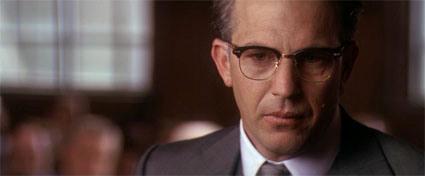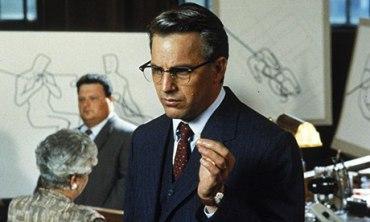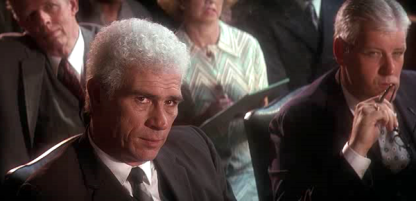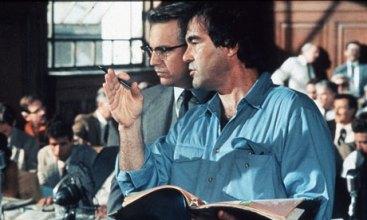 Kevin Costner as D.A. Jim Garrison in Oliver Stone’s JFK
Kevin Costner as D.A. Jim Garrison in Oliver Stone’s JFK
“Let There Be Light” – And Let Us Be Illuminated By It
Continuing with my rumination on a course I once developed concerning Hollywood and the Historical Film, exactly how much history and how much fiction does one include in such an undertaking? On the flip side of the issue, is there anything we may wish to exclude?
Questions of this nature pose a perplexing problem for the instructor, in that the focus of the course is placed exclusively on the limitations and uses of available sources. And a lot is riding on those same sources!
For example, one can turn to the Bible, a primary source for many people’s moral and ethical education, and ask the obvious question: “Is the Bible history, and can it be used to teach history?” First and foremost, such a query must take into account matters of fact, faith and fiction, in addition to myths, legends and the all-important religious interpretation of events.
This is a delicate subject to broach with students because it goes to the very core of their belief system and upbringing. Inside an academic setting, it’s a perfectly valid form of inquiry and well within reason. But outside academia, one must tread lightly so as not to offend those same beliefs. Therefore, let us proceed with caution.
To begin our analysis, what should one make of the frequent parables present throughout the Biblical narrative? For one thing, we can say that parables, as told by various individuals — Christ primarily — in both the Old and New Testament, serve the purpose of putting a potentially difficult topic or principle into simple, everyday terms. This was done so that the average layperson might understand and absorb their lessons.
Are there ways we can tell how much of what is being conveyed via parables is truth, exaggeration, verbal embellishment or other such extravagances? If by that question one is referring to “fact checking,” that would be a physical impossibility, considering that, for one, we still have the aforementioned distance problem to deal with, as well as the time factor involved in retracing the steps of who said what, where and when so many eons ago.
What about the problem of errors, mistakes or liberties taken with the known (or generally acknowledged) facts? Do the facts found in the Bible, such as they are, coincide with or run counter to the veracity of events as described elsewhere in the historical record? This is the crux of the problem. For if the historical record — those so-called “known facts” — are found not to coincide with the Biblical explanation of events, do we then discard the historical record, or do we drop the Biblical sources as unreliable?
Here’s another interesting case in point, drawn from the Gospels: we know from history that the Roman governor of Judea — the province where the historical Jesus both lived and died — ruled with an iron hand. The reason for this attitude was both practical and plain: to put down rebellion at the first sign of trouble.
How, then, do we explain Pontius Pilate’s reluctance to swiftly carry out that part of Roman justice demanded of his office, i.e., to execute a potential “rabble rouser” such as Jesus, swiftly and at the first sign of trouble? Wouldn’t we expect Pilate to act as any Roman governor would and take matters into his hands, or would different behavior be the norm from him because of his proximity to the Christ?
Depending on who you ask, the Biblical narrative would “seem” to indicate the latter, which somewhat contradicts what scholars, historians and other learned individuals know of the historical Roman governor’s role in Christ’s Crucifixion, or for that matter any crucifixion.
This takes us to the next topic up for discussion: is history truth? Or, to put it another way, is there such thing as historical truth? If there is, how does it compare to, say, Biblical truth? You will notice the paraphrasing of Pilate’s own rhetorical query, “What is truth?”
We have seen that history can be subjective — that is, one’s view of a subject is always taken from the person viewing it, what tends to be called the “subjective vantage point.” Can this view encompass other vantage points — in other words, a more objective one, where a topic, issue or person, for that matter, is interpreted in a less opinionated manner, thereby refraining from pontificating on its substance? Of course it can! But it’s not all that easy, is it?
Again, we come to what I describe as the “invariable variable,” also known as the distance problem rearing its ugly head. By that, I mean to ask: are we so far removed from the Biblical (or prehistorical) context of past events as to be irretrievably separated from them?
The answer to that is: it all depends. Different events in the past can have any number of differing, even multiple, interpretations or meanings, whether or not they are viewed from a subjective or objective angle.
The Kennedy Case

Let’s take one such event from the recent past and examine it from both the subjective and objective vantage points. Certainly one of the most photographed and investigated murder cases of our time: the assassination of President John F. Kennedy by Lee Harvey Oswald, as interpreted by filmmaker, producer and screenwriter Oliver Stone in the movie JFK (1991).
Stone’s film charts a familiar path first set forth 15 years earlier by director Alan J. Pakula’s All the President’s Men, a movie about the Watergate break-in and subsequent investigation of the scandal that brought down President Richard M. Nixon (a subject Mr. Stone tackled separately).
In Pakula’s picture, there are two crusading reporters, Bob Woodward (Robert Redford) and Carl Bernstein (Dustin Hoffman), who write for the Washington Post, headed by Chief Editor Ben Bradlee (Jason Robards). In Stone’s reworking of Kennedy’s untimely death and the ensuing investigation of same, Kevin Costner plays New Orleans District Attorney Jim Garrison, who, as portrayed by Costner, is as far from the real-life fanatical, self-righteous, wrong-headed prosecutor as New York is from Los Angeles.
JFK follows Garrison as he leads his crack team of investigators on a wild goose chase over unsupported terrain: there are charges and counter-charges, dirty dealings and underhanded activities, clandestine meetings, supposed conspiracy theories, angry Cubans, ex-military veterans, contrived or fabricated evidence, numerous blind alleys, red herrings, dead or disappearing witnesses, and whatever else the D. A.’s illogical mind-set conjures up.
Now let us juxtapose Stone’s operatically conceived opus with an actual piece of filmed research, the 1989 documentary Who Shot President Kennedy? Written, directed and produced by Robert Richter, and narrated by news anchor and reporter Walter Cronkite, the level of investigative journalism demonstrated in this 57-minute feature, which takes into account every known facet of the assassination — from footage of the Dallas physicians who tried to save Kennedy’s life, computerized 3-D images of Dealey Plaza, a frame by frame analysis of the Abraham Zapruder footage, and leading critics of the Warren Commission’s findings — puts to shame many of JFK’s most far-fetched conclusions.
To begin with, what did New Orleans have to do with Kennedy’s murder in Dallas, Texas? Quite a lot, as the film would have us believe. In the first place, Lee Harvey Oswald (Gary Oldman in an uncanny personification), the so-called Lone Gunman (a designation made years after the fact), was born there; and in the second, Garrison’s bogus criminal case was aimed squarely at a New Orleans businessman named Clay Shaw (a fey Tommy Lee Jones) and his sometime partner, cross-dresser David Ferrie (a peculiarly manic and foul-mouthed Joe Pesci), scapegoats both.

The result is Rashomon run amok. In the end, one has no idea who to believe or how to separate the “good” guys from the “bad” guys. In reality, Jim Garrison tried his best to sway an incredulous court to convict Clay Shaw on flimsy if not disjointed evidence. If the film had stayed in the Big Easy, it might ultimately have made more sense. As it turned out, though, Stone had his fictional Garrison go in every direction at once, all the while trying his best to keep up appearances as the dedicated D.A. and a devoted family man and husband.
What were those directions? Among the various corners turned, the director had his cast and crew look at the case against Oswald in much the same manner as the above-mentioned documentary, which included the single bullet theory (the timing problem, the angle of trajectory and other issues), the possibility of a Grassy Knoll assassin (or lack thereof), the photographic and acoustic evidence from Dealey Plaza, Oswald’s alleged ties to Cuba and the Soviet Union, his FBI and CIA connections, the president’s body, the supposed “botched” autopsy (or “altered wounds” theory), and so on. Whew, that’s a whole lot of fat to chew on for three hours of movie time!
As we know from past experience, the longer a specific case is investigated, the more it will reveal about itself. In this instance, however, the more the JFK assassination is probed and poked at, the more speculative it gets and the more speculation surrounds it, which only leads to more unanswered questions and “theories” — some of which belong to the realm of fantasy and the bizarre, not to mention the harebrained.
Still, does the fact that the most investigated and photographed case in modern history make the resultant inquiry any more meaningful, or the findings any easier to accept? We know there were many problems with the Warren Commission’s Report, but after watching JFK one is forced to admit that Oliver Stone’s version of events is not without glitches of its own. Bravura film-making, which the director’s motion picture undeniably encompasses, does not a true picture make!
Additional problems are presented or addressed, along with new and ever bolder hypotheses about who killed Kennedy, to include blatant, out-and-out inventions. The question at this point becomes: has Stone taken undue liberties with the facts? Can he beg our indulgence over their use by employing the oft-quoted “poetic license” excuse?

We may put forth a few theories of our own, such as: doesn’t a film’s director have a responsibility — moral, ethical or otherwise — to present the facts as they are? The “truth,” if it indeed exists, is out there (at least, according to The X-Files’ Fox Mulder). Do directors, by their very nature, have their own agendas to pursue, arrived at before filming even begins?
Are they not attempting to fit pieces of evidence, conveniently labeled “the facts,” into a previously developed, predetermined script? And isn’t this another form of manipulation of events, a parable to end all parables, the cinematic Gospel according to Stone?
All of the above certainly merits our attention, which may also warrant further inquiry at our convenience.
(To be continued…)
Copyright © 2014 by Josmar F. Lopes

